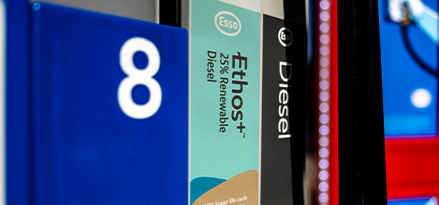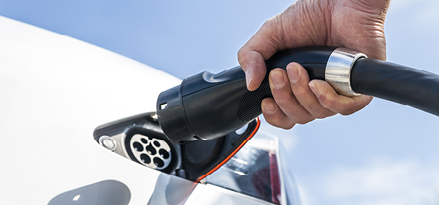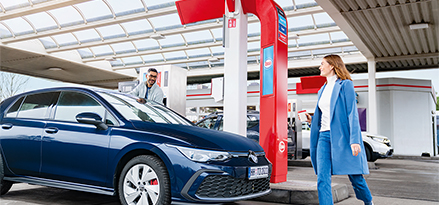Developing lower emission fuels

Esso Ethos+™ 25% Renewable Diesel
Our latest premium diesel can be used in any diesel car and provides the great protection and cleaning power you expect from Esso Synergy fuels – plus it’s made with 25% renewable content, and even has 15% lower life cycle greenhouse gas (GHG) emissions than our regular diesel1. So you can drive with a little less impact, right now.
Discover more on Esso Ethos⁺™ 25% Renewable DieselNew Synergy petrol gives you more efficiency for your journey

The switch to electric vehicles
For those who’ve made the switch to electric cars and need to recharge while on the move, electric charging points are being installed at an increasing number of Esso branded stations across the country. If you’re not near one of our stations, simply use this charging point map to find the closest one to you.
Find a charging point at EssoDeveloping lower emission fuels


Here’s a thought:
-

Plan your fill ups
Rather than waiting until the red light comes on – when you may need to drive out of your way to fill up – call in at your next petrol station when you’re starting to run low.
The more you can plan your fuel stops in advance, the more efficient you can make them. That could mean making them fit better into your daily routine, or finding the quietest time to fill up – but don’t make a special journey if you can help it.
-

Collect Nectar points
Saving fuel saves you money. But if you do have to top up, buy your fuel from Esso and collect Nectar points. You can then swap these and save 5p a litre on your next fill4.
Find out more

Sign up to receive updates on our latest Thoughtful Driving initiatives and offers*
Sign up for our emails to receive inspiring news, offers and fuel-saving ideas.
Join nowMore about Thoughtful Driving
1 Comparison is versus regular Esso Synergy Diesel. Esso Ethos+™ 25% Renewable Diesel contains a minimum of 25% renewable diesel. Choosing Esso Ethos+™ 25% Renewable Diesel instead of regular Esso Synergy Diesel results in 15% lower greenhouse gas emissions when comparing the emissions over the life cycle of each fuel. Fuels vary both in their total life cycle emissions (i.e. from production to use or “well to wheel”) and in how the emissions are distributed throughout that life cycle. The methodology for calculating life cycle emissions and emissions reduction follows that outlined in the Renewable Transport Fuel Obligations Order 2007 (SI 2007/3072) as amended (“RTFO”). Actual results may vary. For more details about the product and full details of the calculation including assumptions and emission factors visit https://www.esso.co.uk/en-gb/hvo-faqs. ©2024 ExxonMobil. All trademarks used herein are trademarks or registered trademarks of Exxon Mobil Corporation or one of its subsidiaries.
2 Production facility expected to be completed in 2025. Anticipated production of up to 6MB/year of renewable diesel. As reference, ExxonMobil global refining throughout is 4.1MB/day (Source: Strathcona: The road to renewable fuel | ExxonMobil; EM Annual Report 2023)
3 Products not available as part of our fuel product offering. Reductions in Carbon Intensity (CI) estimates are based on the lifecycle greenhouse gas emission of the fuels tested at Toyota’s Research Center, compared to petroleum gasoline. Estimated CI values are based on either GREET 2021 estimates, or feedstock Proof of Sustainability documents. Actual results may vary. America’s future: ExxonMobil & Toyota | ExxonMobil
4 Available at participating Esso branded service stations.
*See full T&Cs here


